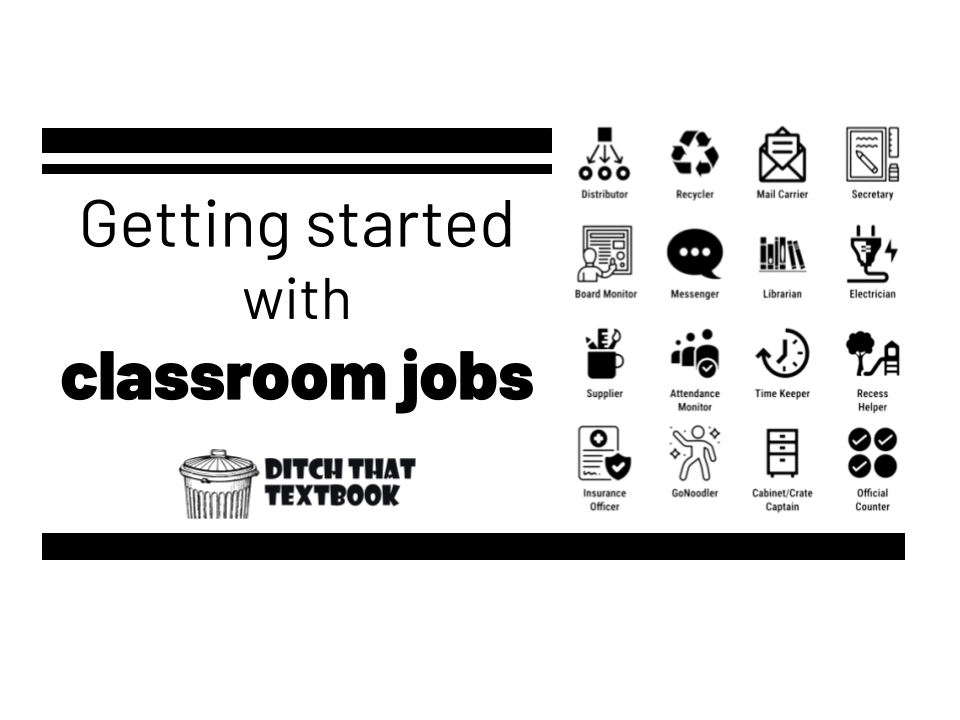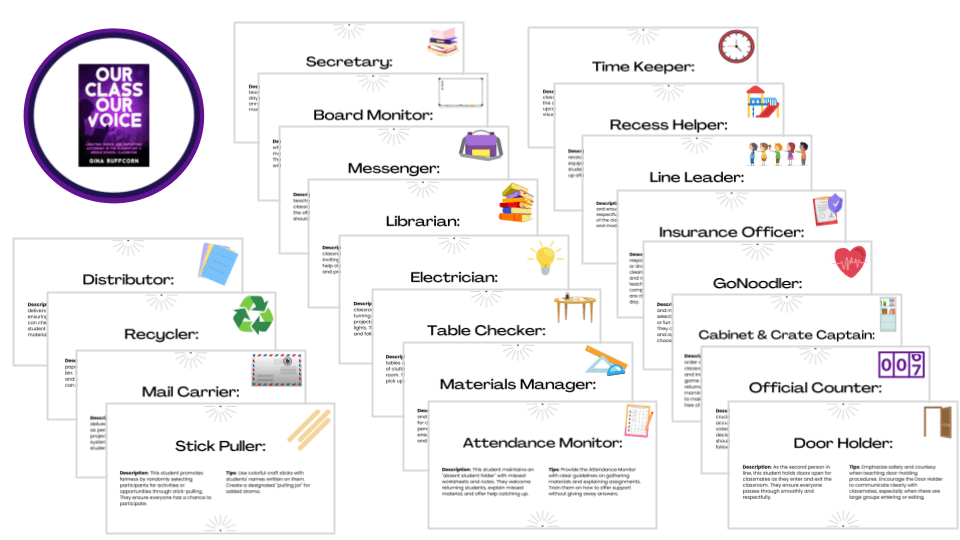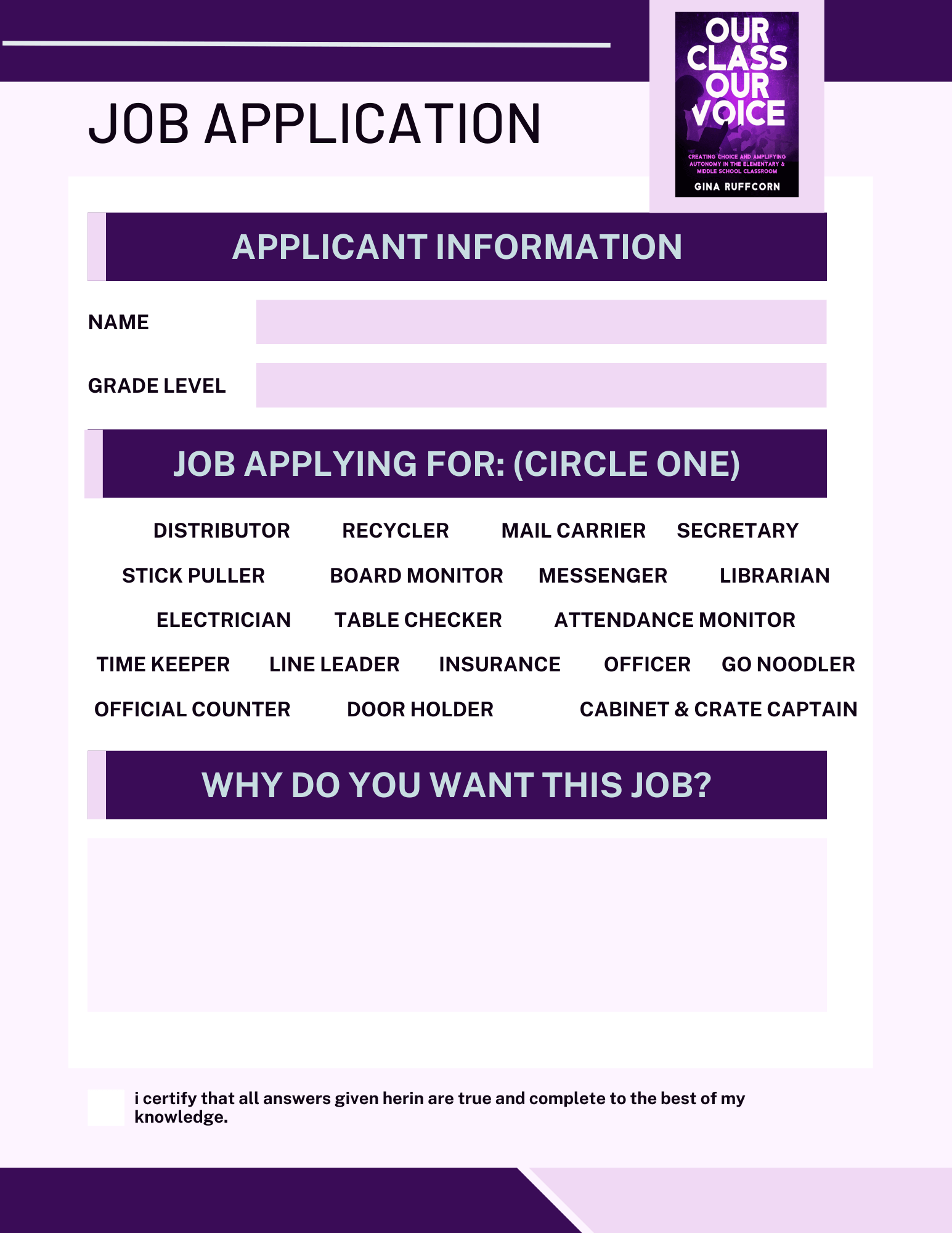
Involving students in classroom responsibilities isn't just about easing the teacher's workload (although that's a nice perk!). It's about creating a vibrant learning environment that fosters essential skills like responsibility, collaboration, and leadership.
Encouraging student participation and fostering a sense of ownership in the classroom environment can be achieved through the simple yet powerful tool of classroom jobs. These jobs go beyond delegating tasks; they offer valuable learning opportunities that develop responsibility, teamwork, and essential life skills.
In a four part video series I chat with Gina Ruffcorn, a fantastic fifth-grade teacher and author of Our Class, Our Voice, who swears by classroom jobs.
Gina explained how classroom jobs not only give students more control and a voice in the classroom, but also take a ton of tasks off the teacher's plate. We even brainstormed a bunch of different jobs students can tackle, from timekeeper to insurance officer (yes, you read that right!).
Gina also shared her tips for assigning jobs and handling situations where a student isn't quite a perfect fit for their assigned role. Spoiler alert: it involves popsicle sticks!
This post provides a comprehensive overview of incorporating student jobs into your classroom, drawing inspiration from Gina Ruffcorn's job descriptions and expanding on them with additional job ideas (for larger classes) and practical tips.
Getting Started with classroom jobs:
1. Choose Your Crew:
Reflect on your classroom routines and identify areas where student assistance would be beneficial. Consider tasks related to organization, materials management, and classroom upkeep.
Start by brainstorming a list of jobs that suit your classroom needs and age group. Consider including tasks like:
- Distributing papers
- Recycling classroom waste
- Delivering notes or mail
- Maintaining the classroom library
- Keeping the whiteboard clean
- Helping with technology
Select a variety of jobs that cater to different student strengths and interests. This ensures inclusivity and allows everyone to contribute meaningfully.
Below you will find a list of the jobs that Gina uses in her classroom along with a description and some tips for implementing them. Bonus: Scroll down below this list to find a Canva template with 20 job cards that you can edit and print to use in your class.

Ms. Ruffcorn's Classroom Jobs
Distributor:
- Description: This student carefully delivers papers to each classmate, ensuring everyone receives a copy. They can check names off a list or ask each student to confirm they have their materials.
- Tips: Train the distributor on efficient delivery methods (e.g., passing by rows, delivering to small groups at a time). Rotate this job frequently to give everyone a chance.
Recycler:
- Description: This student ensures all paper waste goes in the recycling bin. They empty the bin when full and educate classmates on what can and cannot be recycled.
- Tips: Create clear signage for recycling bins and involve the Recycler in teaching classmates about recycling best practices.
Mail Carrier:
- Description: This student collects and delivers mail within the classroom, such as permission slips or completed projects. They can maintain a mailbox system or distribute directly to students.
- Tips: Designate a specific area for student mailboxes. Use colorful folders or envelopes to personalize the experience.
Secretary:
- Description: This student helps Ms. Ruffcorn stay organized by writing the day's agenda on the board, announcing schedules and menus, and maintaining the classroom planner.
- Tips: Provide pre-formatted templates for the agenda and planner. Allow the Secretary to personalize announcements with their own flair.
Stick Puller:
- Description: This student promotes fairness by randomly selecting participants for activities or opportunities through stick-pulling. They ensure everyone has a chance to participate.
- Tips: Use colorful craft sticks with students' names written on them. Create a designated "pulling jar" for added drama.
Board Monitor:
- Description: This student keeps the whiteboards clean and tidy by erasing markers and checking for smudges. They can also remind classmates to write neatly on the boards.
- Tips: Provide the Board Monitor with different colored erasers and cloths for variety. Make board care a team effort by having two students share the responsibility.
Messenger:
- Description: This student helps Ms. Ruffcorn with errands outside the classroom, such as delivering notes to the office or fetching supplies. They should be responsible and trustworthy.
- Tips: Equip the Messenger with a designated "delivery bag" or pouch. Train them on proper communication etiquette when interacting with other adults.
Librarian:
- Description: This student keeps the classroom library organized and inviting. They shelve books by genre, help classmates find what they need, and promote reading initiatives.
- Tips: Involve the Librarian in creating genre labels and library decorations. Allow them to recommend books to classmates based on their interests.
Electrician:
- Description: This student manages the classroom's electrical equipment, turning lights on/off, operating the projector, and caring for seasonal lights. They should be safety-conscious and follow clear instructions.
- Tips: Create a visual chart outlining procedures for operating each device. Ensure the Electrician understands the importance of conserving energy.
Table Checker:
- Description: This student ensures tables and surrounding areas are clear of clutter before students leave the room. They can remind classmates to pick up scraps and push in chairs.
- Tips: Make table checking a quick team effort with two students working together. Use a positive and encouraging approach when reminding classmates to clean up.
Materials Manager:
- Description: This student distributes and collects various materials needed for classroom activities, such as pencils, papers, scissors, or glue. They ensure everyone has what they need and keep track of supplies.
- Tips: Train the materials manager on organization and inventory management skills. Provide a designated storage area for commonly used materials.
Attendance Monitor:
- Description: This student maintains an "absent student folder" with missed worksheets and notes. They welcome returning students, explain missed material, and offer help catching up.
- Tips: Provide the Attendance Monitor with clear guidelines on gathering materials and explaining assignments. Train them on how to offer support without giving away answers.
Time Keeper:
- Description: This student helps the class stay on schedule by monitoring the clock and reminding everyone of upcoming transitions. They can use a visual timer or countdown chart.
- Tips: Choose a student who is organized and responsible. Allow them to personalize the timekeeping method with creative timers or charts.
Recess Helper:
- Description: This student assists during recess by retrieving forgotten equipment, accompanying injured students to the nurse, and helping line up after playtime.
- Tips: Clearly define the Recess Helper's responsibilities and safety protocols. Provide them with a walkie-talkie or other communication device to reach Ms. Ruffcorn if needed.
Line Leader:
- Description: This student leads the line and ensures everyone behaves respectfully while transitioning in and out of the classroom. They can set the pace and model good behavior.
- Tips: Train the Line Leader to be familiar with the dismissal or entry process. Rehearse leading the line a few times before the actual transition.
Insurance Officer:
- Description: This student acts as a responsible helper in case of spills, mishaps, or dropped items. They can assist with cleanup, provide tissues or paper towels, and report any major messes to Ms. Ruffcorn. Additionally, they ensure the computer cart is organized and all lockers are closed and secured at the end of the day.
- Tips: Train the Insurance Officer on basic spill-cleaning procedures and safety protocols. Provide them with a designated cleaning kit and remind them to prioritize safety over speed.
GoNoodler:
- Description: This student brings energy and movement to the classroom by selecting engaging GoNoodle activities or fun morning exercises for the week. They consider classmates' preferences and age-appropriateness while choosing activities.
- Tips: Allow the GoNoodler to showcase their creativity by coming up with their own themed activities or incorporating music and props. Involve the class in voting on their favorite choices periodically.
Cabinet & Crate Captain:
- Description: This student maintains order and organization within the classroom. After "unplugged" mornings and indoor recesses, they tidy up the game cabinet, ensuring games are returned properly. On Monday mornings, they check everyone's crates to make sure they are organized and free of clutter.
- Tips: Provide the Cabinet & Crate Captain with clear guidelines on how games should be stored and organized. Make checking crates a collaborative effort by having them partner with another student.
Official Counter:
- Description: This student plays a crucial role in classroom democracy by accurately counting and recording votes during class discussions or decision-making processes. They should be detail-oriented and able to follow clear instructions.
- Tips: Use different counting methods (e.g., tally marks, manipulatives) to cater to different learning styles. Teach the Official Counter how to present results clearly and fairly.
Door Holder:
- Description: As the second person in line, this student holds doors open for classmates as they enter and exit the classroom. They ensure everyone passes through smoothly and respectfully.
- Tips: Emphasize safety and courtesy when teaching door-holding procedures. Encourage the Door Holder to communicate clearly with classmates, especially when there are large groups entering or exiting.
Classroom job card template

2. Make it Official:
Create a visually appealing chart or display board showcasing the available jobs and their descriptions. This helps students understand their roles and responsibilities.
Consider having students apply for the jobs that they want to have. This allows students the opportunity to practice filling out a job application and can help them identify the skills they already have that make them good at certain positions.

3. Assign and Rotate:
Involve students in the selection process. Allow them to choose their preferred jobs while ensuring everyone gets a chance to participate in different roles. Assign jobs fairly, considering student preferences and ensuring everyone gets a chance to participate. Rotate jobs regularly to distribute responsibilities and foster diverse skill development.
4. Train and Empower:
Don't just assign tasks and walk away. Clearly explain the purpose and responsibilities of each job to students. Use visuals and demonstrations when necessary to ensure understanding. This sets them up for success and fosters a sense of ownership.
5. Celebrate and Recognize:
Acknowledge students who consistently fulfill their duties and go the extra mile. A simple "thank you" or a shout-out can make a big difference in motivating them and inspiring others.
Bonus Tip:
Get creative! Consider incorporating student jobs into your curriculum. For example, the "Classroom Photographer" could document science experiments, while the "Class Journalist" could write reports on historical events studied in class.
Other job ideas:
- Class Podcaster: Create a monthly podcast.
- Tutorial Creator: Make educational videos for classmates.
- Tech Guru: Assist with technology in the classroom.
- Teaching Assistant: Support the teacher with various tasks.
- Mindfulness Leader: Lead mindfulness activities.
- KonMari (Organizing Specialist): Help organize the classroom.
- Motivational Speaker: Share weekly motivational messages.
- Class Barista: Serve and prepare class snacks or drinks.
- Class Yogi: Lead class yoga sessions.
- Greeter: Welcome classmates and visitors.
- Photographer: Capture class activities and events.
- Videographer: Record class happenings.
- Journalist: Create a class newsletter or report on class events.
- Botanist: Care for class plants.
- Zoologist: Take care of class pets, if any.
- Meteorologist: Report and discuss the weather.
- Historian: Document class activities and maintain a class scrapbook.
- Biographer: Interview and write about classmates.
- Attendance Monitor: Keep track of daily attendance.
By incorporating student jobs into your classroom, you'll be surprised by the positive impact it has on your students' engagement, responsibility, and overall learning experience. Remember, it's all about creating a collaborative environment where everyone feels valued and contributes to the success of the team!


